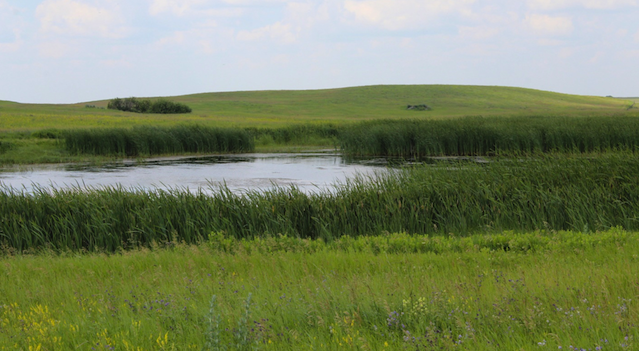The U.S. Fish and Wildlife Service’s Small Wetlands Acquisition Program (SWAP) provides a solid foundation for conservation delivery and contributes to fulfilling the goals of the 2005 PPJV Implementation Plan (Plan). The Plan calls for perpetually protecting through easement acquisition an additional 1.4 million acres of wetlands and over 10 million acres of grassland. The SWAP has contributed to this goal by perpetually protecting almost 350,000 wetland acres and over one million grassland acres through conservation easements from 1987 through 2015. In addition, over 250,000 acres of land has been purchased in fee title and these lands are open to the public and provide recreational opportunities.
The development of the SWAP began more than 50 years ago. In the 1940’s, significant reductions in waterfowl populations were noted by a South Dakota Refuge Manager, Fred Staunton, who believed these reductions were the result of wetland drainage. In addition, national awareness of the loss of prairie wetlands was featured in a Field & Stream magazine article titled “Good-Bye Pot-Holes”, by Clay Schoenfeld. Due to this article and through other communication and awareness efforts, Congress officially created the SWAP in 1958 by amending the 1934 Migratory Bird Hunting and Conservation Stamp Act (commonly referred to as the Duck Stamp Act) to allow proceeds from the sale of Federal Duck Stamps to be used to protect waterfowl habitat.
In the late 1950’s easement acquisition of wetlands began across the Prairie Pothole Region (PPR). Willing landowners agreed to sell to the U.S. Fish & Wildlife Service their drainage, filling, leveling and burning rights on those wetland basins. In 1961, the Wetlands Loan Act was approved that authorized an advance of funds against future revenues from the sale of ducks stamps as a means of accelerating the acquisition of migratory waterfowl habitat. This was an important action as it allowed land managers to meet landowner demand for easements in a more timely manner. Soon after, Wetland Management Districts were created throughout the PPR to administer the wetland easements and fee lands acquired under the SWAP.
Today, funding sources for the SWAP are varied across the PPJV and include, but are not limited to, funds from the Migratory Bird Hunting and Conservation Stamp Act, North American Wetlands Conservation Act, Land and Water Conservation Act, non-government organizations, and private donors. Many dollars have been contributed to the SWAP by these acquisition Acts and donors, however, funding is still a limiting factor to reaching the goals of the PPJV Implementation Plan as the landowner waiting list for an easement offer is substantial in North and South Dakota.
The SWAP continues to be a highly successful conservation program for protection of a unique landscape that is dotted with wetlands surrounded by grasslands that are highly productive and support an incredible diversity of wildlife.
For more information, contact Randy Renner, Manager of Conservation Programs – Land Protection, Ducks Unlimited Great Plains Region or Tammy Fairbanks, North Dakota Supervisory Realty Specialist, U.S. Fish and Wildlife Service

